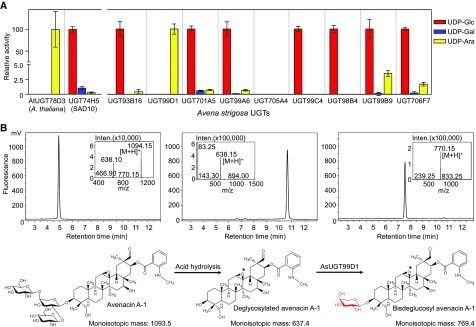Figure 3.
Biochemical Characterization of Candidate Oat UGTs
(A) Evaluation of sugar donor specificity of recombinant oat UGTs using the universal acceptor TCP. Relative activities with different sugar nucleotide donors are shown. Conversion of TCP to TCP glycoside was monitored by spectrophotometry at 405 nm. The previously characterized oat N-methyl anthranilate glucosyltransferase AsUGT74H5 (SAD10) and Arabidopsis flavonoid arabinosyltransferase UGT78D3 were included as controls. Values are means of three biological replicates; error bars represent sds.
(B) LC-MS profiles for avenacin A-1 (left), deglycosylated avenacin A-1 (middle), and the product generated by incubation of deglycosylated avenacin A-1 with AsUGT99D1 (right) (detection by fluorescence; excitation and emission wavelengths 353 nm and 441 nm, respectively). The hydrolyzed avenacin product is shown with an intact 12,13-epoxide (*), but this epoxide may have rearranged to a ketone under the acidic hydrolysis conditions resulting in deglycosylated 12-oxo-avenacin A-1, as observed in Geisler et al. (2013).

